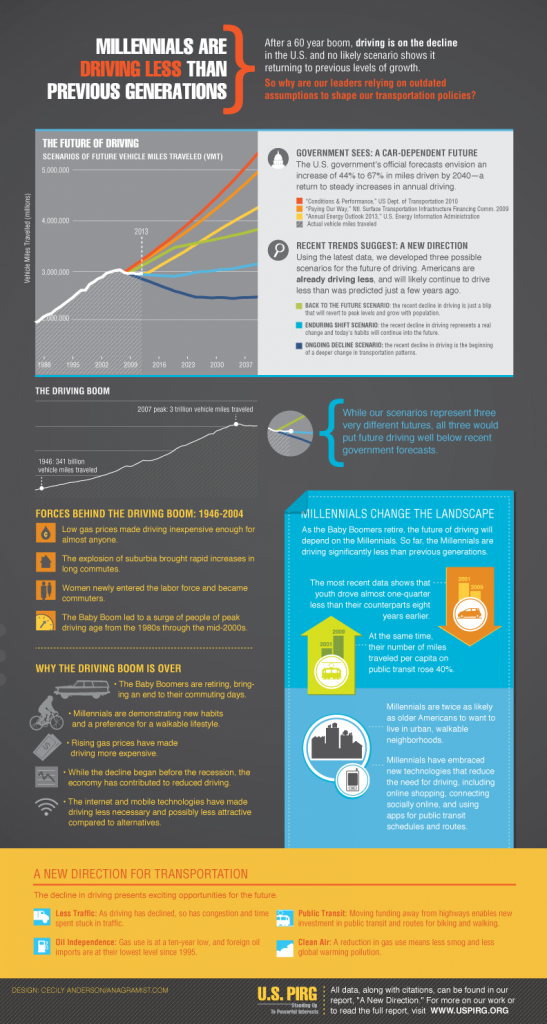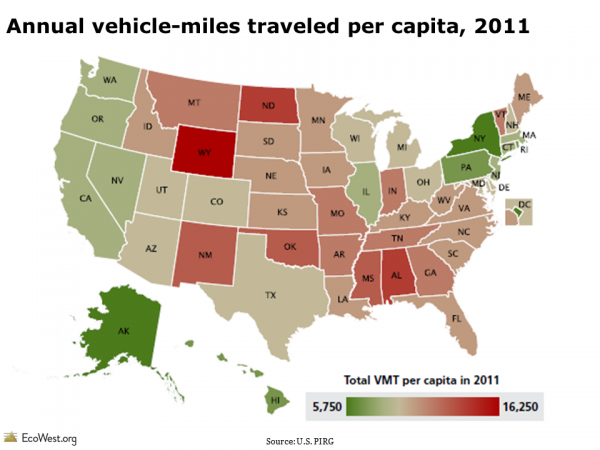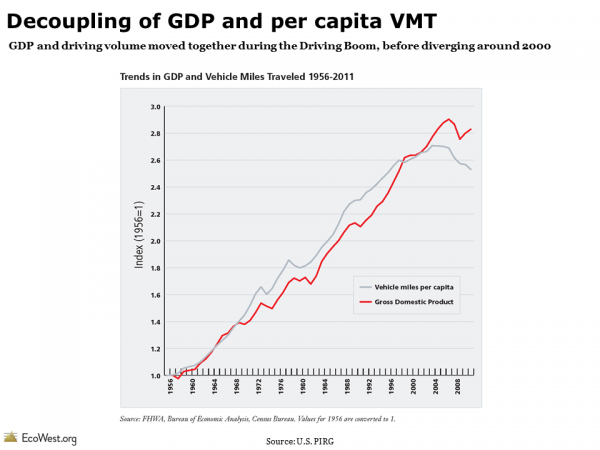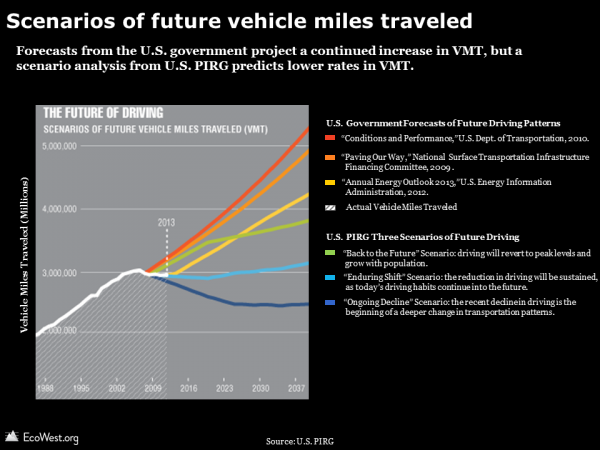At the peak of the recession, did you swap your family’s annual summer road trip for a “staycation” or plan errands to reduce your number of car trips? Have you engaged in the semi-competitive practice of hypermiling? If so, you’re far from alone in your quest to reduce your annual mileage behind the wheel, according to a recent report from the U.S. Public Interest Research Group (PIRG).
In the report, “Moving Off the Road: A State-by-State Analysis of the National Decline in Driving,” U.S. PIRG shows that 46 states plus the District of Columbia have experienced a reduction in the average number of driving miles since 2004.
The report counters U.S. government forecasts, which have traditionally held that economic conditions and driving activity are directly related: as the economy improves, driving would be expected to increase. But U.S. PIRG found no correlation between the per capita decline in driving and how states fared economically in recent years. Here’s their summary infographic:

The study puts transportation policy—and the tens of billions of dollars associated with it—in a new light. Joanna Guy, program associate with the Maryland PIRG Foundation, framed the situation this way:
Given these trends, we need to press the reset button on our transportation policy. Just because past transportation investments overwhelmingly went to highway construction doesn’t mean that continues to be the right choice for [the] future.
End of the “driving boom”
During the nearly six-decade “driving boom” that began in 1946, Americans increased their driving nearly every year. Nationally, per capita vehicle-miles traveled (VMT) peaked in the year 2004 and began to decline prior to the recession, which suggests that something other than the economy is behind the drop-off in driving.
In an earlier report released this spring, U.S. PIRG identified a few factors that contributed to the end of the driving boom:
- The baby boom generation is retiring, leading to far fewer commuting miles.
- Millennials are driving significantly less than previous generations and prefer a more walkable, public transit-oriented lifestyle.
- Rising gas prices have increased the cost of driving.
- The depressed economy has reduced transportation demands for some sectors, even though the driving decline started prior to the recession.
- New technologies, such as online shopping, have curbed the number of trips to stores, while smartphone apps for public transit schedules have made it easier to incorporate bus and rail trips into one’s lifestyle, particularly in dense urban areas.
There are only four states (North Dakota, Nevada, Louisiana, and Alabama) where driving miles per capita in 2011 were above their 2004 or 2005 levels. Since 2005, several states—including Alaska, Delaware, Oregon, Georgia, Wyoming, and South Carolina—have actually seen double-digit percent reductions in per capita VMT.
State-by-state driving differences
The average American drove roughly 9,500 miles in 2011, but there are big differences in driving patterns at the state level. For instance, the average Wyoming resident drives more than 16,000 miles annually, while District of Columbia residents drive less than 5,775 miles each year. Within the West, the average resident drives around 10,200 miles annually, with Washington State residents reporting the lowest annual figure at 8,300 miles.
According to the report, no single factor alone can explain the difference in per capita driving across states. The study examined multiple variables—population density, median household income, frequency of working from home—and found only a rough correlation between more urban populations and lower VMT.
Nationwide, urban residents drive about 9,930 miles per year, while rural residents drive an average of 14,850 miles. Wyoming has the second-lowest population density in the country, so you would expect it to fall on the upper end of the VMT range.
Driving decline: more than an economic aftershock
Although the recent recession has undoubtedly influenced the national per capita decline in driving, U.S. PIRG argues that the trend should not be perceived as a short-lived byproduct of the recession. It cites four reasons:
- Per capita driving began declining before the recession, with VMT peaking in 2004.
- Other metrics, such as the percentage of young people with a driver’s license and the number of vehicles per household, also started declining prior to the recession.
- Per capita driving declined among both the employed and unemployed.
- Per capita VMT and national GDP moved in tandem throughout the driving boom (1960s to early 2000s). At the beginning of the 21st century, the two indicators decoupled: GDP continued to increase, while driving fell or remained steady.
Reimagining future transportation policy
By default, U.S. transportation engineers typically estimate there will be a continually rising number of drivers on the road in the future. A range of government forecasts have all projected a steady increase in annual driving, with the expected increase by 2040 ranging from 44% to 67%.
U.S. PIRG, however, created its own scenarios for the future of driving, all of which predict lower VMT trendlines than government forecasts, as shown in the chart below.
The U.S. PIRG report opens the conversation on why and how we might re-envision the country’s transportation policy. In light of tight budgets for transportation projects, there is fierce competition for every dollar. Funds diverted from a potentially superfluous highway expansion could be used to improve alternative transit options, such as bus routes and bike lanes.
Research suggests that investing in alternative forms of transportation is more than a feel-good policy: it can also boost economic development. A study by the University of Vermont Transportation Research Center found that housing prices in Baltimore tended to increase based on the proximity to bicycle lanes.
Data sources
You can download the full report and accompanying data for “Moving Off the Road: A State-by-State Analysis of the National Decline in Driving” from U.S. PIRG here.
The data is also accessible on this dashboard.
Downloads
- Download Slides: PIRG VMT (4550 downloads )
- Download Notes: PIRG VMT (4612 downloads )
- Download Data: PIRG VMT (4661 downloads )
EcoWest’s mission is to analyze, visualize, and share data on environmental trends in the North American West. Please subscribe to our RSS feed, opt-in for email updates, follow us on Twitter, or like us on Facebook.





